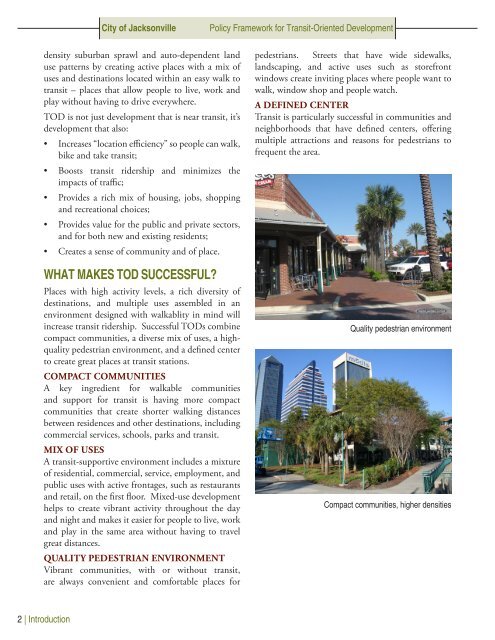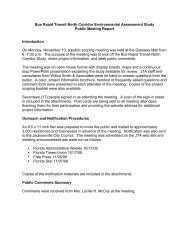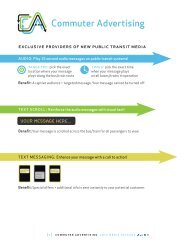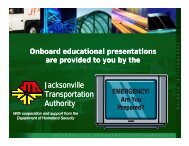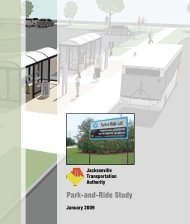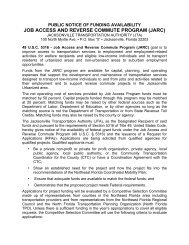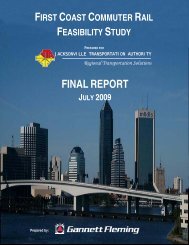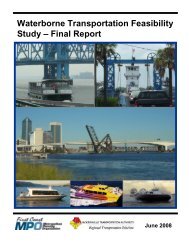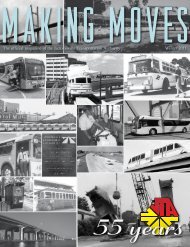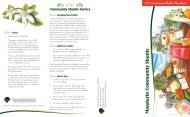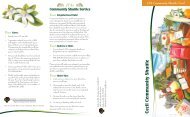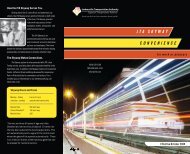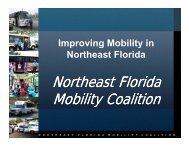Policy Framework - Jacksonville Transportation Authority
Policy Framework - Jacksonville Transportation Authority
Policy Framework - Jacksonville Transportation Authority
Create successful ePaper yourself
Turn your PDF publications into a flip-book with our unique Google optimized e-Paper software.
City of <strong>Jacksonville</strong><br />
<strong>Policy</strong> <strong>Framework</strong> for Transit-Oriented Development<br />
density suburban sprawl and auto-dependent land<br />
use patterns by creating active places with a mix of<br />
uses and destinations located within an easy walk to<br />
transit – places that allow people to live, work and<br />
play without having to drive everywhere.<br />
TOD is not just development that is near transit, it’s<br />
development that also:<br />
• Increases “location efficiency” so people can walk,<br />
bike and take transit;<br />
• Boosts transit ridership and minimizes the<br />
impacts of traffic;<br />
• Provides a rich mix of housing, jobs, shopping<br />
and recreational choices;<br />
• Provides value for the public and private sectors,<br />
and for both new and existing residents;<br />
• Creates a sense of community and of place.<br />
What Makes TOD Successful?<br />
Places with high activity levels, a rich diversity of<br />
destinations, and multiple uses assembled in an<br />
environment designed with walkablity in mind will<br />
increase transit ridership. Successful TODs combine<br />
compact communities, a diverse mix of uses, a highquality<br />
pedestrian environment, and a defined center<br />
to create great places at transit stations.<br />
Compact Communities<br />
A key ingredient for walkable communities<br />
and support for transit is having more compact<br />
communities that create shorter walking distances<br />
between residences and other destinations, including<br />
commercial services, schools, parks and transit.<br />
Mix of Uses<br />
A transit-supportive environment includes a mixture<br />
of residential, commercial, service, employment, and<br />
public uses with active frontages, such as restaurants<br />
and retail, on the first floor. Mixed-use development<br />
helps to create vibrant activity throughout the day<br />
and night and makes it easier for people to live, work<br />
and play in the same area without having to travel<br />
great distances.<br />
Quality Pedestrian Environment<br />
Vibrant communities, with or without transit,<br />
are always convenient and comfortable places for<br />
pedestrians. Streets that have wide sidewalks,<br />
landscaping, and active uses such as storefront<br />
windows create inviting places where people want to<br />
walk, window shop and people watch.<br />
A Defined Center<br />
Transit is particularly successful in communities and<br />
neighborhoods that have defined centers, offering<br />
multiple attractions and reasons for pedestrians to<br />
frequent the area.<br />
Quality pedestrian environment<br />
Compact communities, higher densities<br />
2 | Introduction


